String Quartet No. 2 (Mendelssohn)
The String Quartet No. 2 in A minor, Op. 13, was composed by Felix Mendelssohn in 1827.[1] Written when he was 18 years old, it was, despite its official number, Mendelssohn's first string quartet. The quartet draws much of its inspiration from Beethoven's quartets.
Movements
This work has four movements:
- Adagio – Allegro vivace
- Adagio non lento
- Intermezzo: Allegretto con moto – Allegro di molto
- Presto – Adagio non lento
A typical performance lasts about 30 minutes.
Composition
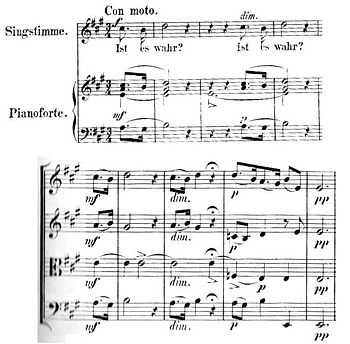
Though Mendelssohn was still a teenager when he wrote this quartet, he was already an experienced composer of chamber music. He had already written the string quintet opus 18, the octet for strings opus 20, and three piano quartets.[2] He had a few months before produced his opera Die Hochzeit des Camacho, which was not a success. (His quartet Opus 12, though it bears an earlier opus number, was actually written two years later.)
Mendelssohn wrote the quartet a year after Ludwig van Beethoven published his last quartets, and months after his death. Beethoven's late quartets received a lukewarm reception at best, and many — including Mendelssohn's own father — agreed with composer Louis Spohr that they were an "indecipherable, uncorrected horror". Mendelssohn, however, was fascinated by them. He studied the scores, and included many quotes from Beethoven's quartets in opus 13.
As a unifying motif, Mendelssohn included a quote from the song "Ist es wahr?" ('Is it true?', op. 9 no. 1), which he composed a few months earlier, for baritone and piano, based on a poem by Johann Gustav Droyson: "Is it true that you are always waiting for me in the arbored walk?" Mendelssohn includes the title of the song in the score of the quartet, recalling the title Beethoven wrote on the last movement of his Op. 135 string quartet "Muss es sein?" (Must it be?). But, unlike the introspective, existential quality of Beethoven's quartet, Mendelssohn's work is richly romantic. "...This quartet, relying heavily on compositional techniques of late Beethoven, links Classical form to Romantic expression," writes analyst Lucy Miller.[3]
Analysis
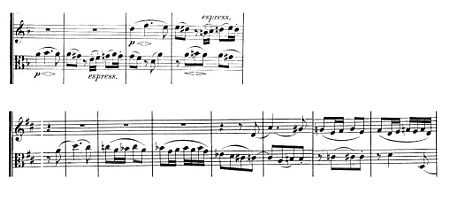
The three-note motif from "Ist es wahr?", presented in an opening Adagio in the key of A Major, establishes the cyclic form of the quartet; the motif appears in all four of the movements, and concludes the quartet.[4] After the Adagio introduction, the quartet breaks into a tumultuous Allegro Vivace in Sonata form in A minor. So the quartet, which is mostly in minor keys, and is primarily minor in character, opens and closes in a major key — a rather daring departure from standard quartet-writing practice of the time. The opening closely resembles Beethoven's Op. 132 quartet:[5] that quartet, also, has an opening adagio, then a first theme built of running sixteenth notes and a lyrical passage, which is close to an inversion of Mendelssohn's theme.
The Adagio movement has a middle slow, fugal section which is modelled after the fugal middle section of the slow movement of Beethoven's Op. 95. The subjects of both fugues are sinuous melodies that slide down chromatically, moving from viola to second violin and then to the other voices. Like the Beethoven model, the fugue goes through a series of increasingly complex variations with cross-rhythms in the different instruments.
The Intermezzo movement opens with a light, gossamer theme which is Mendelssohn's signature style. The lilting theme in the first violin, with pizzicato accompaniment in the other instruments, recalls the overture to the incidental music to A Midsummer Night's Dream (op. 61) and scherzo movements from many of Mendelssohn's chamber works.
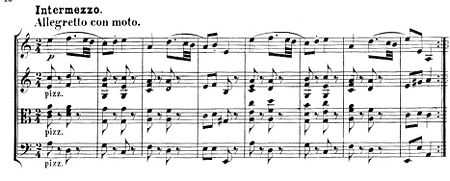
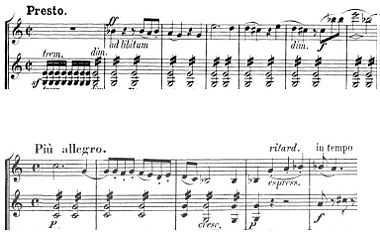
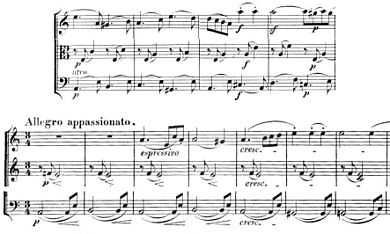
The final movement of Beethoven's Op. 132 quartet is a prototype for Mendelssohn's last movement: it begins with a cadenza interlude in the first violin, leading into a fast, melodic movement with a driving bass line in the cello which is a close copy of the cello part of Op. 132.
Media
 |
|
| Problems playing this file? See media help. | |
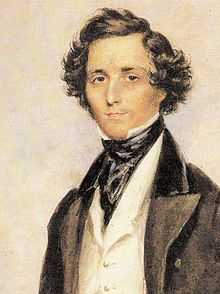
Mendelsson Opus 13, first movement"
by Arcano String Quartet
Erik Sanchez, Mariana Valencia, violins; Miguel Alcantara, viola; Luz Del Carmen Aguila Y Elvira, cello

Mendelsson Opus 13, second movement"
by Arcano String Quartet
Erik Sanchez, Mariana Valencia, violins; Miguel Alcantara, viola; Luz Del Carmen Aguila Y Elvira, cello
References
- ↑ Originally published by Breitkopf and Hartel, 1827. Urtext edition is also published by Henle
- ↑ IMSLP
- ↑ Miller, Lucy (2006) Adams to Zemlinsky Concert Artists Guild ISBN 1-892862-09-3, p. 168
- ↑ For a complete analysis of this quartet, see Griffiths, Paul (1985). The String Quartet: a History. Thames and Hudson. ISBN 0-500-27383-9..
- ↑ For a detailed comparison of the quartet with Beethoven's opus 132, see Gregory John Vitercik, The Early Works of Felix Mendelssohn: A Study in the Romantic Sonata Style (1992) Taylor & Francis, ISBN 2-88124-536-6, pp 227-229; and Uri Golomb, “Mendelssohn’s creative response to late Beethoven: Polyphony and thematic identity in Mendelssohn’s Quartet in A-major Op. 13”, Ad Parnassum: A Journal of Eighteenth- and Nineteenth-Century Instrumental Music, Volume 4, Issue 7 (April 2006): 101-119.
External links
- String Quartet No. 2: Scores at the International Music Score Library Project
- Lecture and performance on this quartet by Roger Parker and the Badke quartet, given at Gresham College, 26 June 2008
| ||||||||||||||||||||||||||